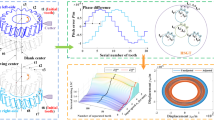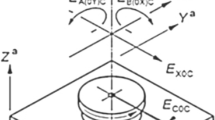Abstract
A lack of accurate description of the meshing characteristics and the corresponding frictional mechanism of the harmonic drive gear has limited progress toward modeling the hysteresis stiffness. This paper presents a method for detection and quantification of the meshing characteristics of the harmonic drive gear based on computer vision. First, an experimental set-up that integrates a high speed camera system with a lighting system is developed, and the image processing is adopted to extract and polish the tooth profiles of the meshed teeth pairs in each acquired video sequence. Next, a physical-mathematical model is established to determine the relative positions of the selected tooth pair in the process of the gear engagement, and the combined standard uncertainty is utilized to evaluate the accuracy of the calculated kinematics parameters. Last, the kinematics analysis of the gear engagement under the ultra-low speed condition is performed with our method and previous method, and the influence of the input rotational speed on the results is examined. The results validate the effectiveness of our method, and indicate that the conventional method is not available in the future friction analysis. It is also shown that the engaging-in phase is approximately a uniform motion process, the engaging-out phase is a variable motion process, and these characteristics remain unchanged with the variation of the input rotational speed. Our method affords the ability to understand the frictional mechanism on the meshed contact surfaces of the harmonic drive gear, and also allows for the dynamic monitoring of the meshing properties.
Similar content being viewed by others
References
Musser C W. Strain Wave Gearing. U.S. Patent, 2906143, 1959-9-29
Ma D H, Wu J N, Yan S Z. Advances in researches of dynamic models in harmonic drive system (in Chinese). China Sciencepaper, 2015, 10: 1983–1990
Zhao J L, Yan S Z, Wu J N, et al. Thermodynamic analysis of a space station remote manipulator with a harmonic drive that considers an integrated thermal protection layer. Sci China Tech Sci, 2015, 58: 1884–1893
Zhao J L, Wu J N, Yan S Z, et al. Dynamic modeling and motion precision analysis of spacecraft manipulator with harmonic drive considering the alternate thermal field in orbit. P I Mech Eng G-J Aer, 2015, 229: 135–148
Radford N A, Strawser P, Hambuchen K, et al. Valkyrie: NASA’s first bipedal humanoid robot. J Field Robot, 2015, 32: 397–419
Liu G J, Liu Y G, Zhang H W, et al. The kapvik robotic mast: an innovative onboard robotic arm for planetary exploration rovers. IEEE Robot Autom Mag, 2015, 22: 34–44
Shen Y W, Ye Q T. Theory and Design of Harmonic Drive. Beijing: China Machine Press, 1985. 1–81
Ivanov M N. The Harmonic Drive. Beijing: Defense Industry Press, 1987. 1–70
Tuttle T D. Understanding and modeling the behavior of a harmonic drive gear transmission. Dissertation for the Master Degree. Cambridge: Massachusetts Institute of Technology, 1992
Gandhi P S. Modeling and control of nonlinear transmission attributes in harmonic drive systems. Dissertation for the Doctor Degree. Houston: Rice University, 2001
Taghirad H D. Robust torque control of harmonic drive systems. Dissertation for the Doctor Degree. Montreal: McGill University, 1997
Preissner C. A high-fidelity harmonic drive model: experiment, simulation, and application. Dissertation for the Doctor Degree. Chicago: University of Illinois at Chicago, 2009
Dhaouadi R, Ghorbel F H, Gandhi P S. A new dynamic model of hysteresis in harmonic drives. IEEE T Ind Electron, 2003, 50: 1165–1171
Tuttle T D, Seering W P. A nonlinear model of a harmonic drive gear transmission. IEEE T Robotic Autom, 1996, 12: 368–374
Gandhi P S, Ghorbel F H, Dabney J. Modeling, identification, and compensation of friction in harmonic drives. In: Proceedings of the 41st IEEE Conference on Decision and Control, Las Vegas, 2002. 160–166
Dhaouadi R. Nonlinear friction compensation in harmonic drives with hysteresis. In: Proceedings of the 2003 IEEE/ASME International Conference on Advanced Intelligent Mechatronics, Kobe, 2003. 278–283
Preissner C, Royston T J, Shu D. A high-fidelity harmonic drive model. J Dyn Syst-T ASME, 2012, 134: 011002–1–011002-13
Tjahjowidodo T, Al-Bender F, Van Brussel H. Theoretical modelling and experimental identification of nonlinear torsional behaviour in harmonic drives. Mechatronics, 2013, 23: 497–504
Taghirad H D, Bélanger P R. Modeling and Parameter Identification of Harmonic Drive Systems. J Dyn Syst-T ASME, 1998, 120: 439–444
Qin K J, Wang E H, Zhao H, et al. Development and experimental validation of a novel hybrid powertrain with dual planetary gear sets for transit bus applications. Sci China Tech Sci, 2015, 58: 2085–2096
Chen X A, Chen H. Analytical geometry method of planetary gear trains. Sci China Tech Sci, 2012, 55: 1007–1021
Chen B K, Fang T T, Li C Y, et al. Gear geometry of cycloid drives. Sci China Ser-E Tech Sci, 2008, 51: 598–610
Yang T F, Yan S Z, Ma W, et al. Joint dynamic analysis of space manipulator with planetary gear train transmission. Robotica, 2016, 34: 1042–1058
Dong H M. Study on kinematics and meshing characteristic of harmonic gear drives based on the deformation function of the flexspline. Dissertation for the Doctor Degree. Dalian: Dalian University of Technology, 2008
Dong H M, Wang D L, Ting K L. Kinematic effect of the compliant cup in harmonic drives. J Mech Design, 2011, 133: 051004–1–051004-7
Dong H M, Ting K L, Wang D L. Kinematic fundamentals of planar harmonic drives. J Mech Design, 2011, 133: 011007–1–011007-8
Chen X X, Liu Y S, Xing J Z, et al. The parametric design of double-circular-arc tooth profile and its influence on the functional backlash of harmonic drive. Mech Mach Theory, 2014, 73: 1–24
Routh B, Maiti R, Ray A K, et al. An investigation on secondary force contacts of tooth pairs in conventional harmonic drives with involute toothed gear set. P I Mech Eng C-J Mec, 2016, 230: 622–638
León D, Arzola N, Tovar A. Statistical analysis of the influence of tooth geometry in the performance of a harmonic drive. J Braz Soc Mech Sci, 2015, 37: 723–735
Ma D L, Liu C S, Zhao Z, et al. Rolling friction and energy dissipation in a spinning disc. P Roy Soc A-Math Phy, 2014, 470: 20140191-1–20140191-22
Zhang H J, Liu C S, Zhao Z, et al. Energy evolution in complex impacts with friction. Sci China-Phys Mech Astron, 2013, 56: 875–881
Xiang W W K, Yan S Z, Wu J N. A comprehensive method for joint wear prediction in planar mechanical systems with clearances considering complex contact conditions. Sci China Tech Sci, 2015, 58: 86–96
Fan Y G, Cao B H. Technical Manual of the Harmonic Drive. Beijing: Defense Industry Press, 1995. 1–21
Luo P F, Chao Y J, Sutton M A, et al. Accurate measurement of three-dimensional deformations in deformable and rigid bodies using computer vision. Exp Mech, 1993, 33: 123–132
Alegria F C, Serra A C. Automatic calibration of analog and digital measuring instruments using computer vision. IEEE Instru Meas Mag, 2000, 49: 94–99
Silveira Jacques J C J, Musse S R, Jung C R. Crowd analysis using computer vision techniques. IEEE Signal Proc Mag, 2010, 27: 66–77
Környei Z, Beke S, Mihálffy T, et al. Cell sorting in a Petri dish controlled by computer vision. Sci Rep, 2013, 3: 1088–1–1088-10
Branson K. Distinguishing seemingly indistinguishable animals with computer vision. Nat Methods, 2014, 11: 721–722
Hong W Z, Kennedy A, Burgos-Artizzu X P. Automated measurement of mouse social behaviors using depth sensing, video tracking, and machine learning. P Natl Acad Sci, 2015, 112: e5351–E5360
Khoygani M R R, Ghasemi R, Vali A R. Intelligent nonlinear observer design for a class of nonlinear discrete-time flexible joint robot. Intel Serv Robot, 2015, 8: 45–56
Zhao J L, Yan S Z, Wu J N. Analysis of parameter sensitivity of space manipulator with harmonic drive based on the revised response surface method. Acta Astronaut, 2014, 98: 86–96
Yang T F, Yan S Z, Han Z Y. Nonlinear model of space manipulator joint considering time-variant stiffness and backlash. J Sound Vib, 2015, 341: 246–259
Cui L, Cupcic U, Dai J S. An optimization approach to teleoperation of the thumb of a humanoid robot hand: kinematic mapping and calibration. J Mech Design, 2014, 136: 091005–1–091005-7
Zhang H W, Ahmad S, Liu G J. Modeling of torsional compliance and hysteresis behaviors in harmonic drives. IEEE-ASME T Mech, 2015, 20: 178–185
Chen X X, Lin S Z, Xing J Z. The investigation of elongation of the neutral line in harmonic drive. In: Proceedings of International Conference on Computer Design and Applications, Qinhuangdao, 2010. 383–386
Sun C Y, Zhang X. Study of teeth lubrication for harmonic gear drive (in Chinese). Lubr Eng, 2001, 2: 12–13
Canny J. A computational approach to edge detection. IEEE T Pattern Anal, 1986, 8: 679–698
Wu S L, Zhang J. Error Analysis and Data Processing. Beijing: Tsinghua University Press, 2010. 55–60, 175–185
Lira I H, Wöger W. The evaluation of standard uncertainty in the presence of limited resolution of indicating devices. Meas Sci Technol, 1997, 8: 441–443
Wackerly D, Mendenhall W, Scheaffer R L. Mathematical Statistics with Applications. 7th ed. Belmont: Thomson Higher Education, 2008. 392–393
Author information
Authors and Affiliations
Corresponding author
Rights and permissions
About this article
Cite this article
Ma, D., Wu, J. & Yan, S. A method for detection and quantification of meshing characteristics of harmonic drive gears using computer vision. Sci. China Technol. Sci. 59, 1305–1319 (2016). https://doi.org/10.1007/s11431-016-6082-6
Received:
Accepted:
Published:
Issue Date:
DOI: https://doi.org/10.1007/s11431-016-6082-6




